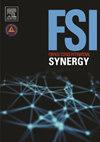Application of bloodstain pattern analysis (BPA) to reconstruct a staged crime scene in a complex forensic case
Q1 Social Sciences
引用次数: 0
Abstract
Bloodstain Pattern Analysis (BPA) constitutes a critical component of modern forensic science, particularly in complex crime scenes where the physical evidence may be manipulated or misinterpreted. This manuscript presents a detailed reconstruction of a residential scene initially suspected to be the site of a violent homicide. Despite extensive blood distribution across multiple rooms, forensic investigation revealed that the injuries sustained were superficial and incompatible with the volume and morphology of the bloodstains observed. A systematic application of BPA, revealed patterns predominantly consistent with passive and transfer mechanisms. Specific attention was given to void patterns—unstained areas interrupting otherwise continuous blood distributions—which were geometrically consistent with object repositioning and indicative of post-event manipulation. Integration of BPA with clinical wound assessment, genetic profiling, and contextual behavioral analysis allowed investigators to identify the scene as staged. High-resolution photographic documentation played a pivotal role in the accurate characterization of the bloodstains, enabling precise evaluation of stain edges, distribution, and mechanisms of deposition. This case underscores the necessity of interdisciplinary collaboration and adherence to updated forensic standards to avoid investigative misdirection and ensure the integrity of crime scene interpretation.
应用血迹模式分析(BPA)重建一个复杂的法医案件的阶段性犯罪现场
血迹模式分析(BPA)是现代法医科学的重要组成部分,特别是在物证可能被操纵或曲解的复杂犯罪现场。这份手稿呈现了一个住宅现场的详细重建,最初被怀疑是暴力杀人的现场。尽管大量的血液分布在多个房间,法医调查显示,所受的伤害是浅表的,与所观察到的血迹的体积和形态不相符。系统应用双酚A,揭示模式主要符合被动和转移机制。我们特别注意到空洞模式——未染色的区域中断了连续的血液分布——这在几何上与物体重新定位一致,表明了事件后的操纵。双酚a与临床伤口评估、基因分析和情境行为分析相结合,使调查人员能够确定现场是阶段性的。高分辨率的摄影记录在准确描述血迹方面发挥了关键作用,可以精确评估血迹的边缘、分布和沉积机制。该案件强调了跨学科合作和遵守最新法医标准的必要性,以避免调查误导并确保犯罪现场解释的完整性。
本文章由计算机程序翻译,如有差异,请以英文原文为准。
求助全文
约1分钟内获得全文
求助全文
来源期刊

Forensic Science International: Synergy
Social Sciences-Law
CiteScore
4.90
自引率
0.00%
发文量
75
审稿时长
90 days
 求助内容:
求助内容: 应助结果提醒方式:
应助结果提醒方式:


